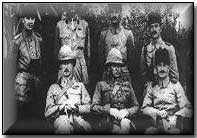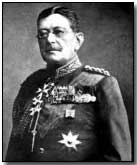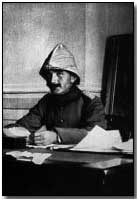Battles - The Siege of Kut-al-Amara, 1916
 Following the signal (and, to
the British at least, unexpected) failure of the Anglo-Indian attack upon
Ctesiphon in November
1915 Sir
Charles Townshend led his infantry force, the 6th (Poona) Division, on a
wearisome retreat back to Kut-al-Amara, arriving in early December.
Following the signal (and, to
the British at least, unexpected) failure of the Anglo-Indian attack upon
Ctesiphon in November
1915 Sir
Charles Townshend led his infantry force, the 6th (Poona) Division, on a
wearisome retreat back to Kut-al-Amara, arriving in early December.
Aware too that his force was exhausted and unable to retreat further Townshend resolved to stay and hold Kut, a town of key importance to the British presence in the region. In this he was supported by regional Commander-in-Chief Sir John Nixon. The War Office in London however favoured a retreat still further south; however by the time this news reached Townshend he was already under siege.
Consequently the defence of Kut - sited in a loop of the River Tigris - was set in train ahead of the arrival of the besieging Turk force of 10,500 men on 7 December. However Kut's very geographical formation in effect meant that Townshend and his men were effectively bottled up.
Nevertheless the division's cavalry were despatched back to Basra the day before the arrival of the Turkish force (6 December 1915), since they were likely to prove of little use and yet a drain upon scarce resources during siege operations.
Leading the Turks were Nur-Ud-Din and the German commander Baron von der Goltz. Their instructions were straightforward if steep: to force the British entirely from Mesopotamia.
 Consequently
Nur-Ud-Din and von der Goltz attempted to pierce Kut's defences on three
separate occasions in December; all however failed. Thus the Turks set
about blockading the town while despatching forces to prevent British relief
operations from succeeding in reaching Kut.
Consequently
Nur-Ud-Din and von der Goltz attempted to pierce Kut's defences on three
separate occasions in December; all however failed. Thus the Turks set
about blockading the town while despatching forces to prevent British relief
operations from succeeding in reaching Kut.
In Britain, as in India, the news of Townshend's setback had stunned the government which resolved to immediately send additional forces to the region, diverted from the Western Front. Consideration was given to regard both Palestine and Mesopotamia as a single front.
Townshend was led to expect rapid relief. He himself calculated that there were enough supplies to maintain the garrison for a month (subsequently revised to two months and then to almost five), although this assumed full daily rations.
Informed that a relief operation might take two months to assemble Townshend proposed instead breaking out and retiring further south: Nixon however insisted that he remain at Kut and therefore tie up as many Turkish forces as possible.
In due course the first British expedition to raise the blockade was set underway from Basra in January 1916, led by Sir Fenton Aylmer. Their efforts were repeatedly repulsed however with heavy loss, at Sheikh Sa'ad, the Wadi and Hanna in January 1916 and again two months later in March at Dujaila.
 April
brought a further relief operation, this time led by the sceptical
Sir George
Gorringe. Despite meeting von der Goltz and his Turkish Sixth Army,
piercing their line some 30km south of Kut, the expedition ran out of steam and
was abandoned on 22 April.
April
brought a further relief operation, this time led by the sceptical
Sir George
Gorringe. Despite meeting von der Goltz and his Turkish Sixth Army,
piercing their line some 30km south of Kut, the expedition ran out of steam and
was abandoned on 22 April.
With no further hope of relief - a final attempt by the paddle steamer Julnar to reach the town with supplies having failed - Townshend requested and received an armistice pending surrender talks on 26 April.
The Turks agreed to send 10 days of food into the garrison while the six-day armistice was in effect. While the talks were in progress the British took the opportunity of destroying anything of value in the town, aware of its imminent surrender.
An additional 23,000 British casualties have been suffered during the relief efforts; the Turks lost approximately 10,000 men.
Although Khalil Pasha, Baghdad's military governor, proved sympathetic to Townshend's offer of £1 million plus a guarantee that none of his men would be used again in fighting against the Ottoman Empire - effectively buying parole, he was instructed by Minister of War Enver Pasha to require Townshend's unconditional surrender.
 This
was duly delivered on 29 April 1916, the British having run out of food supplies
and wracked with disease of epidemic proportions (and with entirely inadequate
medical provisioning to meet it).
This
was duly delivered on 29 April 1916, the British having run out of food supplies
and wracked with disease of epidemic proportions (and with entirely inadequate
medical provisioning to meet it).
It was the greatest humiliation to have befallen the British army in its history. For the Turks - and for Germany - it proved a significant morale booster, and undoubtedly weakened British influence in the Middle East.
Approximately 8,000 Anglo-Indian troops were taken prisoner (many weak through sickness), as was Townshend himself. However whereas he was treated as something of an honoured guest (and ultimately was released to assist with the Ottoman armistice negotiations in October 1918), his men were treated with cruelty and routine brutality, with a significant percentage dying while in captivity.
Baron von der Goltz meanwhile did not live to witness the conclusion of siege operations; he died ten days earlier of Typhus, although rumours persisted (unproven) that he was actually poisoned by a group of Young Turk officers.
Click here to view a map charting operations in Mesopotamia through to 1917.
Battles and Engagements of the Relief Operation
| Battle | Date |
|---|---|
| Battle of Sheikh | Opened 6 January 1916 |
| Battle of the Wadi | Opened 13 January 1916 |
| Battle of Hanna | Opened 21 January 1916 |
| Battle of Dujaila | Opened 8 March 1916 |
| First Battle of Kut | Opened 5 April 1916 |
Photographs courtesy of Photos of the Great War website
Observation balloons were referred to as 'sausages'.
- Did you know?
